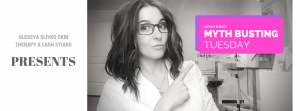
Myth #4: “Oil-Free” foundations do not clog pores or cause acne.
You’re at the store and you come across a new foundation. The display is inviting. You pick it up, scanning for information. The words, Oil-free, jump at you. How could they not? They are written with an impossible to miss font-size that pulls your eyes away from the small print.
The words are like a small voice is whispering “Buy me. I won’t clog your pores like those other brands”. It feels safe.
Truth: Oils are not the only ingredients that clog pores. There are other ingredients used in foundations and creams that can cause clogged pores and acne development: Myristyl Myristate, Red Dyes, Isostearyl Alcohol, PEG 8 Stearate, etc..
The reality is that if you read ingredient list of Oil-Free makeup, you may find fatty acids and esters. These are so known “synthetic oils” and they are actually more likely to irritate your face. But since natural oils are not used in a formulation, manufacturers can put Oil-Free on the label.
Nowadays, you can find pretty much any kind of makeup or skin care product in Oil-Free version. The Oil-Free label is just another great marketing trick that Cosmetic companies use to fool consumers, and make their products more appealing to women who believe that oil will make their breakouts worse.
Look for the word Noncomedogenic on the label for skin products if you have skin that is oily, acne prone and clogged easily. Noncomedogenic means that an ingredient or product doesn’t clog pores and cause black or white heads.
